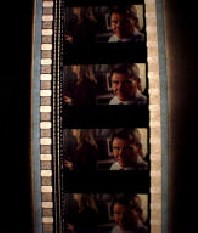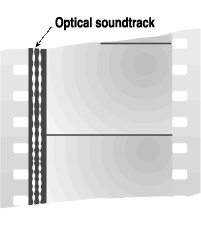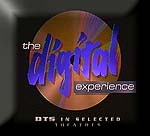
The contents of this page are really for historic purposes only.
Since the advent of digital movie presentation, the material discussed here
is of little significance.
With digital presentation of the visuals, movie sound is now always digital,
stored in LPCM format. UniMovies do have a sound system capable of
presenting 7.1 stereo, as we have replaced our old (pre-digital) processor -
a Dolby CP500 - with a digital only processor Datasat AP20, which leaves us with a
facility for screening 35mm in all three film digital sound formats.
Whenever you go to a cinema, there are many different sound formats you may encounter. This document attempts to describe the technical details of these methods of generating sound in a cinema. There is no attempt made to follow a chronology, although the sequence is pretty close. We'll limit discussion to 35mm film.
First, here's a diagram of what a piece of present-day 35mm film looks like:

Let's start with a traditional optical soundtrack.
Up until the early 1990s, most sound for movies was printed onto the film
along with the picture, located between the picture
frame and the sprocket holes on one edge of the film as shown below.

The optical soundtrack is an analog of the sound. This means that the varying loudness and frequency of the sounds has been converted to a corresponding ability of the film to pass light through it. This soundtrack is either varying shades of grey (no longer used) or varying proportions of black versus white. In the early days of film sound, the former method generated a soundtrack that looked like lines of varying opaqueness running across the track, while the latter system looked like a symmetric wriggly line down the length of the film. This second form is now the only one used. The optical soundtrack is processed by projecting light through the film from an exciter lamp and detecting the transmitted intensity with a solar cell which converts the changes of brightness to changes in volume and pitch of sound. There are a pair of signals on current films which are processed by a split solar cell which can convert each of the tracks to a separate channel producing stereo sound. This is called SVA or stereo variable area analog sound.
So that filmmakers and film sound reproduction manufacturers worked together, a standard for the theatre playback response of an optical soundtrack was developed in the '30s called the Academy Curve.
This remained the standard for movie sound until the '70s when cinema patrons, used to the quality of stereo sound at home expected more from movies. Of course, magnetic soundtracks had been used from the '50s to provide multi-channel sound but the costs were generally too high, both for the production of the film print (as the magnetic stripes had to be added to the film after it had been made photographically and then the sountrack recorded onto it) and also for the theatres (to provide multiple amplifiers and speaker systems for the small number of films using magnetic tracks). So theatregoers could expect mostly mono sound in their cinemas up to the mid '70s.
During the '70s, Dolby experimented with placing two separate sound signals on the film. Because of the reduction in the detail that could be incorporated when reducing the area available for the analog signal, Dolby also incorporated noise reduction with a resultant change in the playback response from the Academy Curve. The first film to use this purely stereo sound was "Lisztomania" in 1975. However the biggest step in movie sound was developed from the semi-popular fad of the '70s - quadrophonic sound. Several version of quad were around but two of the most popular, QS and SQ, involved matrixing the four channels Left Front, Right Front, Left Rear and Right Rear into the regular two stereo channels and then using a matrix decoder to extract the four channels back. Of course, there is no way of getting these four separate channels back out of only two pieces of information so each of the four resulting channels contained parts of the other three (poor channel separation). Steering electronics attempted to accentuate the required components of each of the four channels, sometimes very effectively.
Dolby decided that cinema sound needed a centre channel particularly for dialogue placement without regard for audience position, so the four movie channels became Left, Centre, Right and Surround (or Effects). For a cinema to be able to reproduce Dolby Stereo, the owners would have to install three sets of extra speakers (and the corresponding amplifiers): two behind the screen on the left and right sides to complement the already existing centre speakers, and one set around the side walls and on the rear wall to output the extra surround channel containing sound effects and ambience. Although many companies now produce equipment to decode this matrixed sound (and to encode it), Dolby Stereo was the standard, with an associated response curve.
With the incorporation of noise reduction in the stereo signals, cinema sound was now on a par with home hi-fi's, with far wider frequency response and much lower distortion than conventional mono soundtracks. One of the first films to popularise Dolby Stereo was the 1977 film "Star Wars".
In 1986, Dolby developed an improved noise reduction system called Spectral Recording and Dolby SR soundtracks started to appear. Most current film analog soundtracks are produced in Dolby SR although often played through conventional Dolby Stereo sound systems which cannot reproduce the louder peaks present in the SR tracks.
This seemed about as far as the optical analog soundtrack could be pushed, although recent changes to the optics of the reproduction provide slight improvements. The next step was to change to digital storage of the soundtrack.
The first movie presented in multichannel digital sound was "Terminator 2:Judgment Day" in May 1991. The format used was called Cinema Digital Sound(CDS), developed by Kodak. Although a technological success, it failed commercially, and had mechanical problems which manifested in audio defects. Perhaps its most significant developmental flaw was the complete replacement of the optical analog track with the encoded digital data, thus relying solely on the CDS system to deliver the movie soundtrack. It was reported that during some movies the sound would completely drop out at times because the CDS system failed and there was no backup soundtrack. The other problem was that it worked only on 70mm film, restricting it to a very small proportion of mainly large city cinemas.
But Dolby stepped in again, developing a 35mm system for storing digital data on film, but with a conventional SR analog soundtrack for backup if the digital track failed - and also so that only one set of prints would be required for cinemas with or without the ability to reproduce the digital soundtrack. This system was called Dolby SR·D (now called Dolby Digital).
To fit the enormous amount of information onto the film, the digital information had to be compressed using Dolby's AC-3 compression scheme. This takes 5.1 channels (the usual three screen channels Left, Centre, Right, two separate surround channels Surround Left and Surround Right, and a low-frequency SubWoofer channel reproducing only about one tenth of the frequency range and hence only one tenth the bits - hence the .1 - of the others) and compresses the information into a stream of 320 kilobits of data per second. This compression is about 10 to 1 from the original sound and involves some loss offset by psycho-acoustic coding. It should be noted that prior to digital sound the signal sent to subwoofers was filtered from the analog soundtrack. To enable the analog soundtrack to stay, Dolby decided to use the space between the sprocket holes on the soundtrack edge of the film. With four squares of digital information per frame and 24 frames passing through the projector each second, each square has to hold about 3400 bits. The first film in general release with a Dolby SR·D soundtrack was "Batman Returns" in 1992. Here's a picture showing the location of the digital information.

As with any major jump in technology, other companies wanted to get in on the act, resulting in two further competing digital sound systems. These both appeared in 1993.

For the release of "Jurassic Park" a relatively low-cost digital system called DTS (Digital Theatre Systems) was used, with a marketing blitz by Universal to install reproduction equipment in as many cinemas as possible. Also reproducing 5.1 channels, DTS uses a combination of new and old technologies. Instead of printing the digital information on the film, a timecode is placed between the picture and the analog soundtrack. (It can be seen on the picture at the top of this article.) This timecode is then read to synchronise the picture to digital information being read from conventional CD-ROM discs. Because of the increased storage capacity, DTS digital soundtracks need only a 4:1 adaptive compression scheme called APT-X100. This is said to produce no discernible differences between the original soundtrack and the reproduced sound after decompression. The use of separate media enables multi-lingual soundtracks to be used without change of print. Of course, should the digital soundtrack fail, the backup analog track would be in the original language. DTS has also been used for 70mm, theme parks and special event cinemas as well as for providing specialised soundtracks for the visually impaired. The major objection to DTS is the fact that CDs must be shipped with the film.
The third digital system is SDDS (Sony Dynamic Digital Sound) which uses on-the-film digital information like Dolby but on the outer edges of both sides of the film.
First used in the 1993 release "The Last Action Hero", SDDS provides 8 channels, the extras being two further screen channels between the centre and the left and right, called Left Centre and Right Centre. This is a throwback to older 70mm systems used in theatres with very wide screens. Most cinemas don't have five screen speaker systems and the SDDS processor folds down the 5 front channels to the usual three behind-the-screen channels. Sony uses a 5:1 compression system called ATRAC which is also used on their MiniDisc recordable CD system. One of the complaints by many about the SDDS system is that the edges of the film are where the most wear occurs as that part of the film is in abrasive contact with parts of the projector. This would lead to degradation of the digital content with possible loss of data. The SDDS sountrack is protected from some of this by being printed on the lowest emulsion level and also having some backup of the digital information. The P side of the film holds the C (centre), L (left), LC (left centre) and SL (surround left) signals, while the S side has the R, RC, SR and SW (sub-woofer) signals. The P side also has Rmin (mixed R, RC and SR) and SW' (compressed SW) while the S side also has Lmix (mixed L, LC and SL) plus C' (compressed C). There are also varying delays placed on the different channels so that edge damage to a film can be overcome with some manipulation of these extra signals.
So what's happening today?
As each digital system uses different parts of the film, all three
systems can coexist on the one print. In 1994, "Heaven and Earth" was
the first film to be released with two digital sound formats on a
single inventory film print (DD and DTS), and in 1995 "Die Hard with
a Vengeance" signalled another digital movie sound milestone by
featuring DD, DTS and SDDS on a single film print. So now
films are released with one, two, or all three digital systems on the one
print. The unfortunate result of the requirement
for accompanying DTS discs means that often a film is not supplied with the discs
and theatres with multi-formats are forced away from DTS.
What's this surround EX?
Dolby and THX together proposed to add an additional surround channel
on the back wall of the cinema, but not a discrete one. Using the same
matrixing technique as Dolby Stereo, the centre rear channel is decoded
from the left and right surrounds of any of the 3 digital systems.
It is then fed to the rear speakers. A theatre must have three separately
amplified surround speaker sets - left, right and rear. There are
several different competing hardware solutions, just as there are for
decoding Dolby Stereo. Each has its own name - EX is Dolby's.
The first official film specifically mixed for EX is "Star Wars Episode 1".
What does this mean to the cinema-goer?
If a cinema advertises that they have digital sound, they may
have only one of the systems. Thus films in other systems will be
screened using the analog track. Many multiplexes don't have digital
in all their theatres, with advertising such as 'digital at selected
sessions'. Many cinemas still don't have Dolby SR reproduction equipment so
analog tracks are reproduced in vanilla Dolby Stereo. There even
exist some cinemas with mono!!
How can you tell if you are seeing (hearing) a film in digital?
Many cinemas screen a tag before a digital film announcing the
type of digital: the train or helicopter of Dolby, the spinning CD of
DTS, or the rotating tetrahedron of SDDS. Listen for the telltale
stereo surrounds. And the completely discrete screen channels. And of
course the high quality of Digital Sound.
Where does UniMovies fit in here?
UniMovies have invested in all three digital systems, and have installed
the Panalogic version of extended surrounds. Our front channels consist
of separate horns and mid-range speaker enclosures driven by individual
amplifier channels. We have 6 sub-woofers, again each driven by separate
amplifier channels. And finally we have 24 surround speakers organised
into three individual channels. We have a total of over 9000 watts of
amplification.